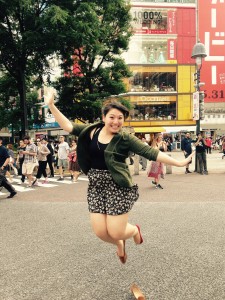
Credit: Henkind
I never knew Taeko Miyoshi. Before today I was unaware of this woman’s existence. Even though we are a part of different generations and reside on completely opposite sides of the globe, we share an important similarity. The year I was born in a small town in Alabama, Taeko was relaying her memories of the atomic bomb that hit Hiroshima. While I took in the world with new eyes, Taeko remembered the last time she saw her mother, an image characterized by her waving a feeble goodbye to young Taeko with a blood-ridden hand. This reflection on a memoir only serves as one example of the thoughts that have been racing through my head on this trip thus far, especially regarding today’s events.
I am currently looking out the window to a lovely view of Hiroshima. While the city is a beautiful sight, I have not been able to shake certain thoughts that make this beauty become suddenly more eerie. If another atomic bomb were to drop at the same exact location, there would be no trace of me left on this earth in a single instant. We can see the river from our hotel room, a body of water that was once filled with floating corpses only seventy years ago. These observations only became more real as we toured the Hiroshima Peace Memorial Museum. It was as if we had somehow wound back the clock to that August 6th morning as we viewed tattered remains of clothing, bits of collected flesh, and wax figures that depicted surreal beings with dangling skin. While all these artifacts put the bombing in a new light, they do not compare to hearing an actual survivor speak of their own personal experience.
Keiko Ogura was only eight years old at the time of the bombing. Since she was farther away from the hypocenter than Taeko Miyoshi, her and her immediate family survived. While you would think that she would have lived a carefree life in comparison to some of the other survivors, this is far from true. Not only has she had to grapple with a constant guilt associated with giving water to severely burned victims and seeing them die as a result, but she has also had to hide her survivor identity for a significant portion of her life due to continual fear of discrimination.
While her telling of her experience was certainly heart wrenching, it was followed by a noble message of hope. Near the end of her presentation, Keiko told us that there are three phases involved in utilizing the memories that she has shared with us. The first we have already completed in that we are actively curious about what happened as a result of the A-bomb and spoke with a survivor to gain first-hand knowledge. The second phase will be complete one we arrive back in the states and tell our friends and family about all we have learned to enlighten them as well. The third and final stage is characterized by how we will make a difference with this newfound information in mind. At this point in her presentation, Keiko directly asked us this question. For a moment I thought she meant it to be rhetorical, but her gaze did not leave me as she nodded in my direction, clearly expecting an answer.
The main reason I wanted to go on this trip is because I longed to know how the current survivors, many of whom were only children when the bomb dropped, have mentally dealt with the consequences of such a traumatic experience and how this trauma has shaped the rest of their lives. Going into college I knew that I wanted to be a nurse practitioner, but it was not until various experiences in the Pierce Service Corps Program and Camp Kesem Emory changed my perspective that I knew that I wanted to specialize in Psychiatric Mental Health, particularly focusing on pediatrics.
As I hear these memoirs, I cannot help but to be reminded of the children that I work with. Kids with emotional disabilities and kids whose parents have or have had cancer are two populations that experience tragic events at a young age, a sad similarity that runs between them and the children of Hiroshima in 1945. I want to work with these children because they are oftentimes unfairly neglected, because they are a key part of the future generation that will be around long after I am gone.
I am looking forward to living out the third phase of this important process as I continue with my education. Even though survivors such as Taeko Miyoshi and Keiko Ogura are rapidly beginning to leave us, their courageous accounts will remain. I am devastated by what occurred seventy years ago, but I will help similar children in need with the memory of Hiroshima closely in mind. Because, as Ms. Keiko herself said, “compared to others, children’s scars stay a long time.”
